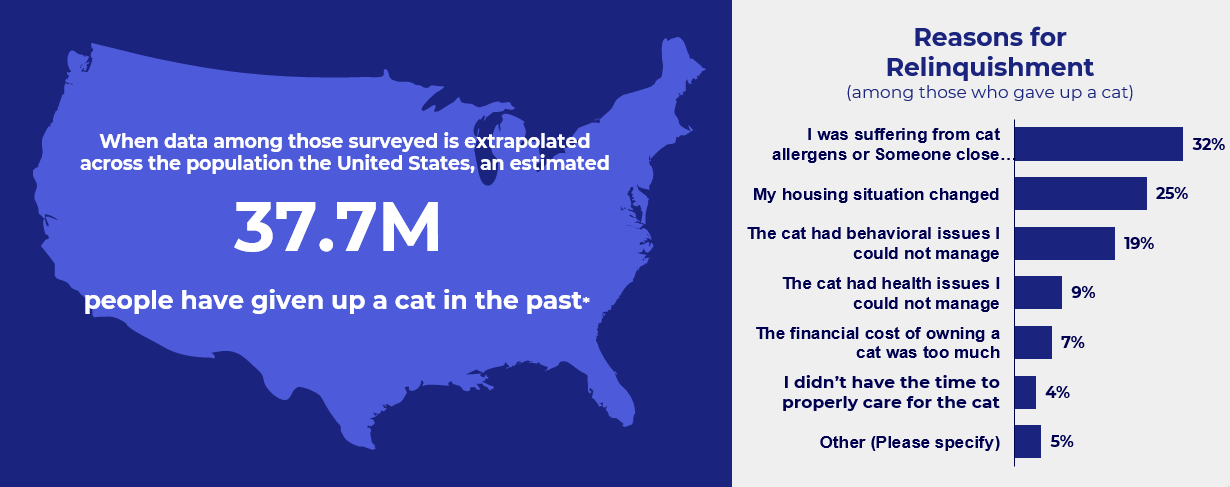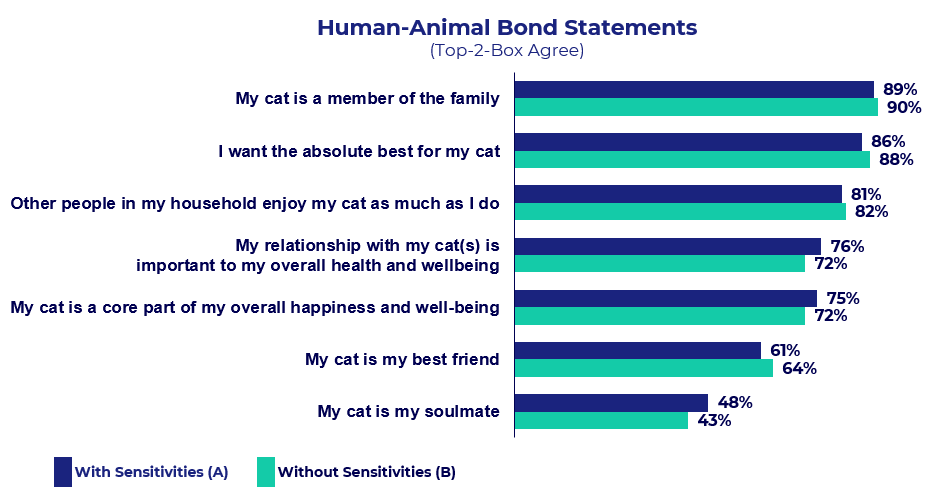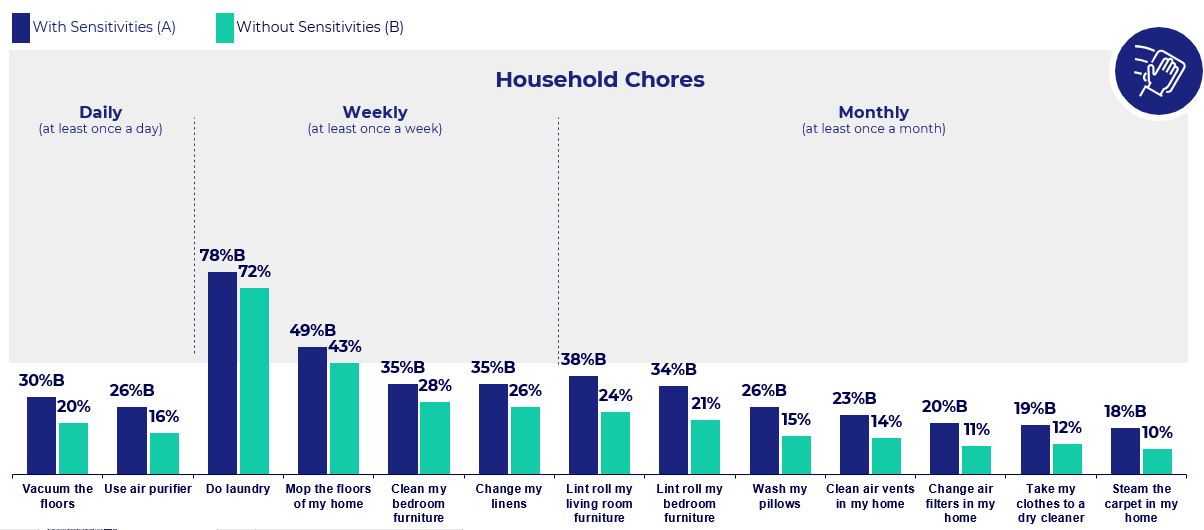For the as many as 1 in 5 adults globally who are affected by cat allergen sensitivities, the daily effort to manage cat allergens and coexist with the cats they love can be a struggle. Despite this, the human-animal bond is strong in owners with sensitivities to cat allergens.
Results from an online survey of 2,062 cat owners conducted by HABRI and Purina Pro Plan suggest that people are willing to go to great lengths to manage their allergies if they can maintain the human-animal bond.
The Impact of Managing Cat Allergens
About a quarter of U.S. cat owners are suffering from cat allergen sensitivities.

The share of cat owners with allergies is not insignificant. 23 percent of cat owners report that either they or a member of their household lives with cat allergen sensitivities. Managing cat-allergens isn’t just a challenge for owners – cats feel the effects as well.

- An estimated 18 percent of the US population or 37.7 million people, have relinquished a cat in the past.
- The most common reason cited for relinquishment (32 percent) is cat allergens.
- When data among those surveyed is extrapolated across the population the United States, an estimated 12 million people have been forced to give up their cat due to allergies.

- Of the total U.S. population, 20 percent would adopt a cat if allergens were not an issue.
- 57 percent of the people who would adopt a cat under these circumstances do not own a cat currently.
- 43 percent already own a cat, but would adopt another.
The Human-Animal Bond
Love for cats is universal and unwavering
The bond between owner and pet cat is strong regardless of sensitivities to cat allergens. All cat owners feel their cat is a member of the family and deserves the absolute best.
The implicit connection between owner and cat is similarly strong, with no significant difference between cat owners with and without sensitivities.
When surveyed on the bond between them and their cat, cat owners with cat allergen sensitivities say:

Households with Sensitivities to Cat Allergens Change Their Lifestyle to Accommodate their Cat More Often than Those Without
People with sensitivities to cat allergens plainly feel strongly about the positive benefits of cat ownership, despite these sensitivities. While cat owners love their cats, households with sensitivities to cat allergens change their lifestyle to accommodate their cat more often than those in households without cat allergen sensitivities.
- 37 percent of owners with sensitivities say they “often” have to change their lifestyle to accommodate their cat, compared to 22 percent of owners without sensitivities to cat allergens
- 26 percent of owners with sensitivities would agree with the statement “cat allergens cause huge problems in my life”, compared to only 8 percent of owners without sensitivities to cat allergens
Reaction to Doctor’s Advice to Surrender Cat

Despite these daily struggles, cat owners are willing to do whatever it takes to keep their cats, going as far as ignoring doctor’s orders. If told by their doctor to give up their cat to help manage cat allergens, 84 percent of cat owners would dismiss the advice. In addition:
- 33 percent would keep their cat and look for other ways to manage their allergens;
- 31 percent would keep their cat and continue standard behavior to manage their allergens
- 20 percent even said they would keep the cat and get a new doctor, showing the need for better management methods.
Impact of Cat Allergens on Human Connection

The majority of survey respondents in households with sensitivities to cat allergens suffer themselves, though two-in-five have others in the household with sensitivities to allergens.
- 31 percent of cat owners surveyed report their partner or spouse suffering from cat allergens.
- 16 percent of cat owners surveyed report it is their child who suffers from cat allergens.
Personal relationships may also be impacted. About one-fourth of households with cat allergen sensitivities say their personal relationships have been strained due to cat allergens.
- 36 percent of cat owners with sensitivities to cat allergens say that they do not like people who dislike their cat. 31 percent of owners without sensitivities say the same.
- 22 percent of cat owners with sensitivities to cat allergens say that their cat(s) increase the amount of stress or conflict in their home.
- 23 percent of cat owners say they have strained at least one personal relationship because of their sensitivities to cat allergens.
- Those with strained relationships are likely to feel anxious (37 percent), conflicted (35 percent), and/or helpless (30 percent).
- 13 percent say that they have had to choose between their cat and a personal relationship as a result of cat allergens.
- 12 percent were forced to consider not living with a partner due to someone’s sensitivities to cat allergens.
- 11 percent of respondents share that they had to end a relationship or friendship due to the strain brought on by cat allergens.
Although cat allergens may strain relationships, many wish it were not so.
- About 1 in 10 say “not being able to have friends/family over to my home” or “missing time with those close to me” is a top limitation of allergens.
- 27 percent of cat owners with sensitivities and 20 percent of those with no sensitivities wished they could spend more time hosting small get-togethers in their home if cat allergens were not a concern.
- Similarly, 23 percent of owners with sensitivities wished they could spend more time hosting more large get-togethers and have guests sleep over more if cat allergens were not a concern, compared to 12 percent and 11 percent of owners without sensitivities, respectively.
Level of Effort
Limitations from Cat Allergens

Cat owners with sensitivities to cat allergens say that they face limitations resulting from their allergies, including in time management, money spent, and the ability to experience the human-animal bond.
- 41 percent of owners with sensitivities say that time spent cleaning the house is a major limitation from cat allergens.
- Cat owners with allergen sensitivities do significantly more household cleaning and cat maintenance
- 40 percent say the physical symptoms of cat allergens present a major limitation to cat ownership.
- Cat owners with allergen sensitivities are forced to spend 26 percent more a month on their cats than those without sensitivities, with 30 percent saying this is a major limitation.
- 24 percent are unhappy with the limitations they must place on themselves when it comes to snuggling with their cat because of allergies.
- Similarly, 18 percent say that limiting the time they can spend playing with their cat is a major limitation from cat allergens.
Those with Sensitivities Do Chores More Frequently

Cleaning the house to help limit the impact of cat allergens is not a straightforward task for many owners, rather, the chores required to limit sensitivities are multifaceted.
- 30 percent of owners with allergen sensitivities vacuum at least once per day, compared to 20 percent of owners that do not
- 26 percent of owners with allergen sensitivities use an air purifier at least once per day, compared to 16 percent of owners that do not
On a weekly basis, cat owners with allergen sensitivities do laundry, mop the floors, clean their bedroom furniture, and change the linens at statistically higher rates than pet owners who do not have any sensitivities to cat allergens.
Monthly, chores that cat owners with allergen sensitivities do at statistically higher rates than cat owners with no sensitivities include:
- Lint rolling the living room furniture (38 percent of owners with sensitivities perform this action monthly)
- Lint rolling the bedroom furniture (34 percent)
- Washing pillows (26 percent)
- Cleaning air vents (23 percent)
- Changing air filters (20 percent)
- Taking clothes to the dry cleaner (19 percent)
- Steaming the carpets (18 percent)
Key Findings
Cat owners living in households with sensitivities to cat allergens are extremely committed to their cats and go through extraordinary lengths to live harmoniously with them.
- The love for cats is ubiquitous among all cat owners, regardless of allergies.
- Cat owners with sensitivities to cat allergens in their household are more likely to change their lifestyle for their cat and/or say cat allergens are a huge problem.
- Cat allergens get in the way of personal relationships.
- Households with sensitivities to cat allergens are spending more time and energy on cleaning and cat maintenance.
- Current methods to manage allergens aren’t easy or effective.
Additional Resources
Methodology





